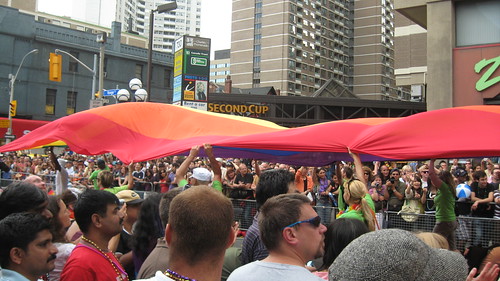
Sunday was the conclusion of Pride Toronto‘s ten-day celebration of the city’s queer communities. Culminating in one of North America’s largest street festivals, the last few days of Pride were packed with arts, community, and celebratory events. This was the first year that I have been living in Toronto during Pride and I was excited to immerse myself in the activities.
One of the most exciting aspects of Pride was seeing how the Church Wellesley Village was transformed during the festival. Large parts of the village were closed to cars, and different activities brought otherwise quiet corners of the neighbourhood to life. I live fairly close to the village, and have walked through its parks and streets before, but Pride really gave me a chance to stop and see a totally different side to some of these spaces.

On Thursday evening I attended the Toronto AIDS Candlelight Vigil at the AIDS Memorial in Cawthra Square park, behind the 519 Community Centre. Comprised of concrete pillars lining an arc-shaped hillock, the memorial, built between 1992-1993, was designed by Patrick Fahn, and was the idea of activist Michael Lynch. By establishing a permanent memorial for victims of AIDS, Lynch hoped to provide a focal point for a community grieving in silence. He hoped that the memorial would help end the shame and stigma surrounding the life and death of people with HIV/AIDS. Although Lynch did not see the memorial completed, the Candlelight Vigil is a testament to the strength of his idea — each year during Pride people gather in front of the memorial to honour, remember, and celebrate those who have died of AIDS, and recognize people currently living with or affected by HIV/AIDS.
I have walked through the memorial before, taking stock of the names inscribed on the stainless steel plaques that are mounted to the concrete pillars, sad to know that more names will be added. The vigil made the importance of the site even more evident.
The ceremony was attended by different stripes of people covering the lawn in front of the memorial. There were songs and stories, somber messages and messages of hope. People representing different communities or demographics that have been affected by the illness — children, aboriginals, transgendered people, sex trade workers, homosexuals, and drug users, among others — conducted the candle lighting ceremony. Near the end of the vigil, when all our candles were lit, the audience was asked to name the names of the people they were celebrating. Names came from across the crowd, at levels of intensity that ranged from whispers to shouts. The names that will be inscribed on the memorial this year were also read aloud.
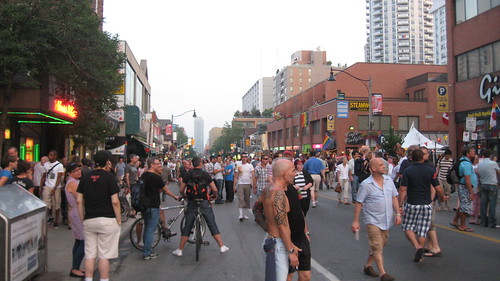
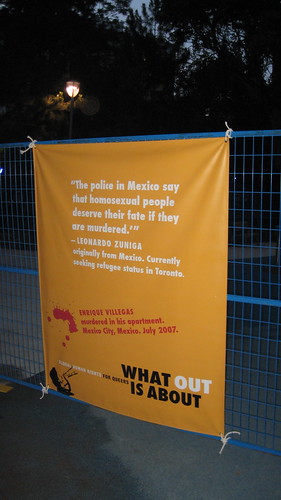
On Friday evening Church Street was beginning to close to cars for the weekend-long street party, and the crowds were starting to build. I checked out the street, but I spent most of the night at Cawthra Square park and the 519 Community Centre again. The 519 Community Centre was presenting Pride Toronto’s first human right’s exhibit, called Global Human Rights for Queers, What Out is About. As a part of the exhibit, there were large banners pinned up outside the 519, bringing light to human rights issues in places as near as Jamaica and Mexico.
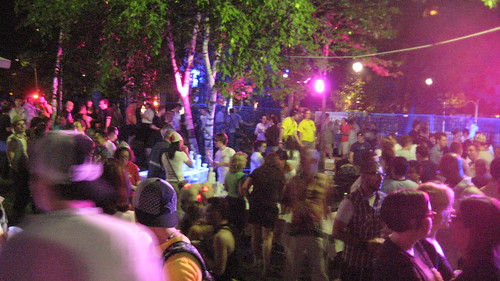
Behind the 519, a large part of Cawthra Square park was transformed for A Starry Night, a free-admission night of music and drinks made by celebrity bartenders. I really enjoyed this event, and not just because Sky Gilbert served me a beer, or because of the relaxed atmosphere and good music. On any other Friday night I wouldn’t make Cawthra Park a destination, but during A Starry Night, the lighting created a great atmosphere and the park had a palpable energy to it. It was refreshing to relax, mingle, and drink in the park.
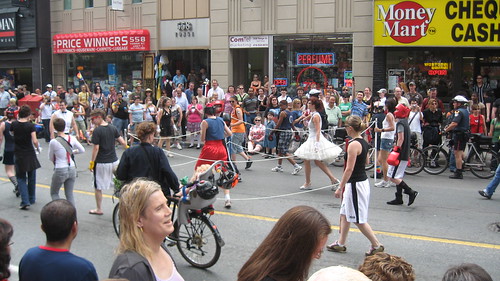
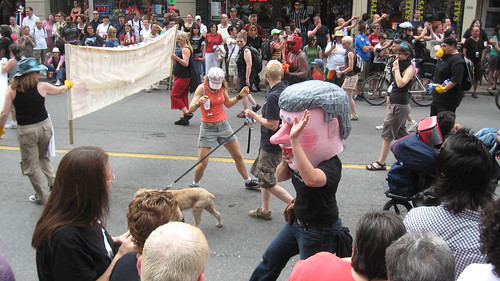
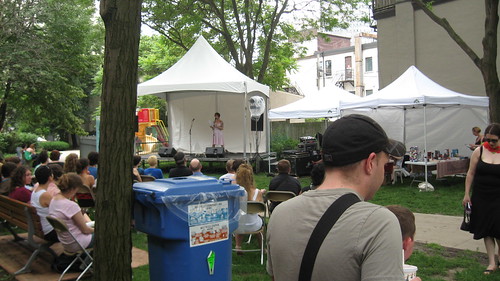
On Saturday afternoon, after I watched the Dyke March, Church and Wellesley Streets were starting to feel packed. I wanted to take a break from the crowds so I took in a Proud Voices reading, presented by Pride Toronto in partnership with The Word on the Street. A celebration of queer writers and storytellers, Proud Voices was at the James Canning Gardens Stage. The park setting was very intimate. I enjoyed Mariko Tamaki’s readings from her graphic novel Skim (despite not actually seeing the graphics).
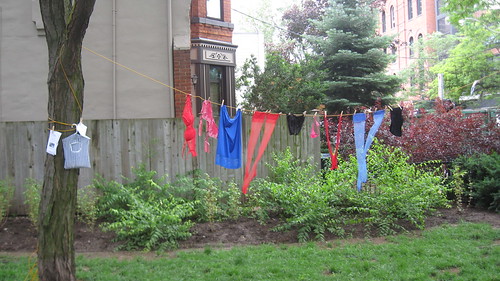
Next to the reading stage was a laundry line covered in lingerie. It was a part of Melissa Levin’s Old School Femme (for Joan Nestle) installation. While I was there, women willing to hang their ‘dirty’ laundry in public were adding to the piece. Levin’s piece was a provocative addition to the park that added a layer of diversity to the different events going on around the village.
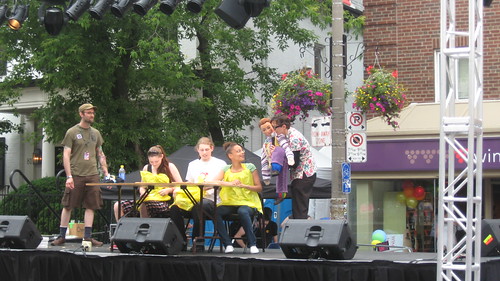
Levin’s installation was a part of the Plot, Engage, Disperse contemporary art exhibit, curated for Pride by Daryl Vocat to promote local queer artists. I also caught artist Lex Vaughan co-hosting the post-Dyke March pie eating contest as a part of Plot, Engage, Disperse (I believe the other host was Daryl Vocat but I missed his name). Vaughan was in character as Diane with her ventriloquist dummy Graham. The contestants attempting to inhale their pies were hilarious, as was Graham’s foul-mouthed commentary, and Diane’s more timid rebukes.
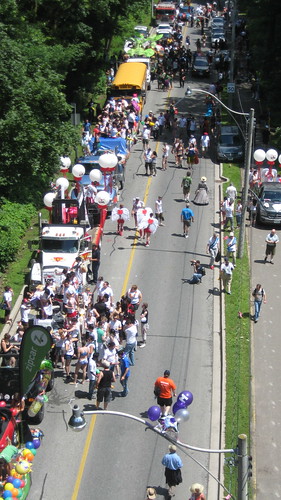
On Sunday afternoon, I got a sneak preview of the Pride Parade when I looked down from Mount Pleasant to where the marchers and floats were lined up on Rosedale Valley Road. I could hear the music from the floats all the way to my apartment. Although Rosedale Valley Road is very scenic, I’ve only ever seen the odd person down there jogging or cycling, aside from the cars that drive along it.




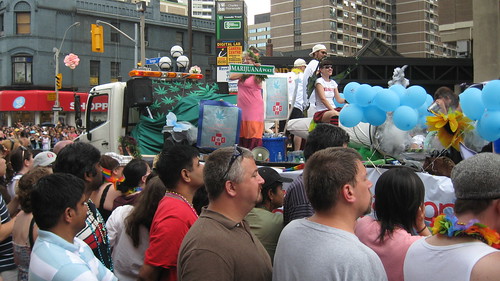
The parade itself was definitely a spectacle, and I enjoyed being on Yonge Street as it was activated by music and colour. I appreciated the many community organizations, activist groups, and different types of people. I can’t say that I’ve ever seen so many people out for one event before, or in one place at one time. Afterward I walked back to Church Street to take in the end of the street party. There was such a great feeling on the street — people seemed to be really being enjoying themselves, out to have a good time.
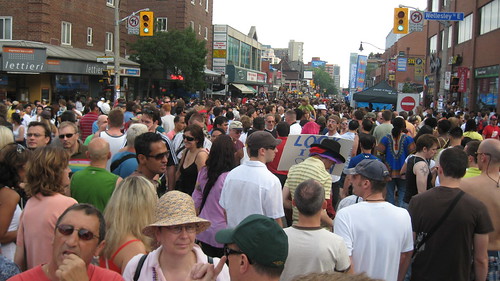
Although I’m a relatively new arrival, the whole event added to the significance of the village to me. Now as I walk though the neighbourhood’s streets and parks I will remember what a great experience I had during Pride.

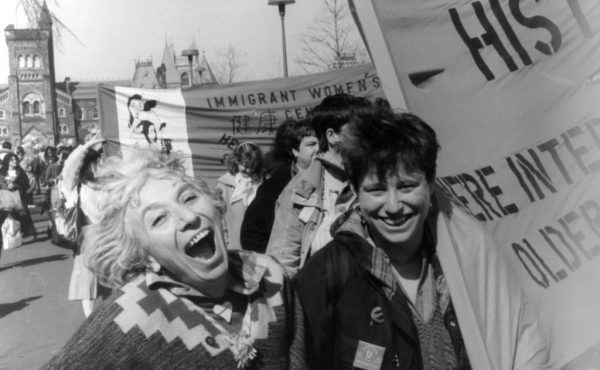

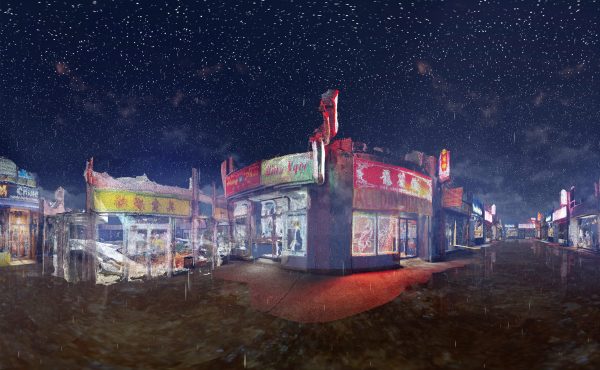
One comment
It’s interesting to read how completely different your pride was from mine. There’s such a diversity of events that there really is something for everyone.
Of course I opted for non-stop partying, but I know that a lot of people had to work very hard for decades for me to be able to celebrate in peace.